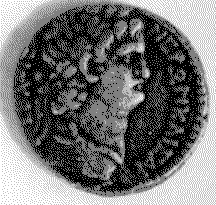
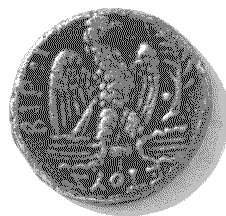
Money is anything
used by people as a convenient means of exchange for goods and
services and of storing wealth. At various times and places many
different things have been money: tools, salt, tobacco, gold dust,
feathers, cloth, animals, tea, obsidian, sea shells, amber, ingots
of silver and copper, glass beads, stones, teeth, nails, even
printed paper.
Coins are a
form of money which are printed, usually with value and issuer.
Money was used extensively in the Neolithic period, and more sparingly
in Paleolithic times. The earliest coins of which we are aware
date to the late 7th Century B.C.
--- Norman Totten, Ancient Vermont
In March 1980 Dr. Norman Totten and I presented slide lectures on the same program at Brigham Young University in Utah, at the invitation of our mutual friend, Dr. Paul Cheesman. Both of us happened to show slides of ancient coins. Immediately afterward, a student approached me with this question, "How does one go about finding an ancient coin?"
He was told, "You don't, they find you." With a dissatisfied look, he wandered over to Totten where he asked the same question and received exactly the same answer.
The problem of the provenance of ancient coins can be summarized in one paragraph of a letter I wrote to Tom Lee, an anthropologist in Quebec:
"I agree with you that it is too bad that ancient coins are found by treasure hunters and amateurs (and housewives and children and chickens) instead of by scholars, but who else is going to find them? If they are authentic, they just are where they are, and found by accident. It is not at all logical to think that a professional archaeologist or anthropologist or numismatist or historian could set out to find one and succeed. Where in God's millions of square miles would he pick to hunt? And if by chance he did find one, then who would say he did not plant it?"
After this was discussed with friend and colleague Alan Gillespie, he said, "As you well know, you would search first in areas with independent evidence of ancient habitation." That sounds reasonable, and a favorite site in western Oklahoma is replete with ancient inscriptions which translate. However, these inscriptions are scattered within an area of 100 square miles. A coin occupies approximately a square inch of space. And not one of the inscriptions says, "Dig here, at this exact spot I intend to lose a coin."
Not being a numismatist like Totten, getting into a position where ancient coins would find their way to this author's attention was a long process.
The Phenix City Coin
The proposal that the discovery of ancient coins in an acceptable context could be supporting evidence of the presence of European and Mediterranean pre-Columbian visitors to America was presented in 1973 in a paper read by Dr. Douglas Braithwaite. The paper was part of a symposium co-sponsored by Dr. Joseph Mahan and Dr. Cyrus Gordon at Westville Village near Lumpkin, Georgia. The paper detailed reports of the discovery of ancient coins in America since 1790, mainly in North Carolina, Tennessee, Kentucky, and Georgia.
The most interesting part of Braithwaite's paper concerned a coin found in 1957 by a small boy in a field near Phenix City, Alabama. This city is on the Chattahoochee River, which forms part of the boundary between Alabama and Georgia and flows into the Gulf of Mexico. The boy took the coin to a local grocer, where he traded it for fifteen cents worth of candy. The grocery man gave the coin to Professor Preston E. Blackwell, a history teacher in the Columbus Center of the University of Georgia. Blackwell sent enlarged photographs of the coin to the Fogg Art Museum of Boston, where officials, apparently judging from the obverse design only, identified it as coming from Syracuse, on the island of Sicily, and dating from 490 B.C. Unfortunately, the professor carried the coin in his billfold, and when he suffered a stroke and was taken to hospitals in Montgomery and Birmingham, the billfold had disappeared and with it, the coin.
The copy of Braithwaite's paper had no illustrations. I made a request in 1977 at the Fogg Art Museum in Boston to see photographs of the coin. I found that they had kept no records. So, like many other research projects, this aspect of the ancient coins remained, at least temporarily, on "hold."
The Oklahoma Nero Coin
On September 24, 1976 an ancient coin was found in
my hometown of Heavener, Oklahoma by Wilbert Stewart. Imperfectly
round, a little smaller than a quarter, the coin appeared to have
a Roman profile and a Greek inscription on the obverse. The reverse
showed an eagle holding a thunderbolt, a palm branch, and two
inscriptions (Fig 11-1).


Fig. 11-1 Nero coin obverse (left) and reverse (right), Oklahoma. Photographs by Mo Mills.
Stewart explained that he had been hired to mow lawns and clean ditches at Hamilton Homes Housing Unit. In a ditch 18 inches deep, he had picked up a pop bottle. Stuck to it with gummy mud was the coin, so encrusted that he thought it was a small round rock. He started to throw it away but noticed it might be metal, so he took it home and scrubbed it for two hours, thus removing the patina. At a visit to the site, Stewart was able to point to where he had found the coin. He was able to relocate the exact spot in the ditch by aligning a crack in the sidewalk and a corner of the building.
Then each occupant of the nearby housing wing was dutifully asked about old lost coins, with no results. The fact that a sidewalk is a now a few feet away and that an asphalt street extends to the edge of the ditch, precludes finding any evidence of an ancient habitation site without major excavations and repairs. The ditch usually contains some water, and the encrusted coin could have washed out of the side of the ditch anywhere along its entire length.
Carefully made drawings and rubbings were sent to both Dr. Barry Fell and Totten in Boston for identification. The coin was later purchased, and it was then mailed to them for confirmation. Totten's report stated, "It is a bronze tetradrachm, originally with a silver wash, now missing. The coin is not a rare specimen. It was struck in Antioch, Syria, 63 A.D."3 According to Fell, "The profile is of Nero, with the Greek inscription on the obverse saying 'Nero Caesar Augustus'."4
The Arkansas Coin
Ancient American artifact or not, the Nero coin served as a herald to another coin which is definitely an ancient American artifact, and which found me only two days later. On September 26, 1976 at 10:30 p. m., while I was making a plaster cast of the Nero coin from a paraffin mold, a stranger knocked on the door. In the indirect manner of people who live in the area around my home, instead of introducing himself, the stranger asked three apparently unrelated questions. "Do you know the curator of the Heavener Runestone State Park?" (My friend, Ferris Haines, thus establishing his reference). "Do you know Hollis Bain? I married his daughter." (A local carpenter, thus identifying himself). "Do you ever work on old coins?" (Giving the purpose of his visit). The door was opened wide and the man was told, "Come IN!"
Jessie Ray Kelley explained that he lived at Cauthron, Arkansas, 19 miles east of Heavener. Both towns lie at the foot of the Poteau Mountain, and both are bordered by the Poteau River, a tributary of the Arkansas River. Kelley said that he spent his leisure time treasure hunting with a metal detector. In the autumn of 1973 while searching in a field at an old house site near Cauthron, he had found an old coin, buried 6 inches deep. He had brought a child's picture book about dolphins and said the coin had a woman's head and four dolphins, "like this."
My sincerity must have been obvious, for when he was told, "THIS I MUST SEE!", he went to his truck and brought the coin in.
It appeared ancient indeed, worn and corroded, with
a green patina in places against the copper color of the coin
(Fig 11-2). It was about the size of a fifty-cent piece, but it
was thick in the center and thin on the edges. There was a small
round hole at top center, as if the coin might once have been
worn as a pendant. On the obverse, a female profile with a straight
high-bridged Grecian nose, faced left. In her curly hair was a
three-pronged ornament. Around the edge swam four dolphins. The
reverse bore the head and neck of a lively horse, facing left.
He had erect ears and a short mane. His mouth was open, as if
he were snorting. Behind his head was a stylized tree with eight
branches, uprooted, showing five crooked roots. Under the horse
head was a very worn inscription. Only four of the symbols were
now plain. The edge of the coin had once been encircled with a
row of tiny dots, worn off except on the sides.
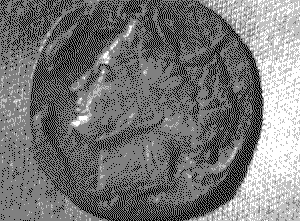
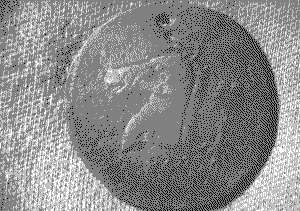
Fig. 11-2 Arkansas coin, obverse (left) and reverse (right). Photographs by Richard Pruitt.
After two hours' conversation, Kelley allowed the coin to be mailed to Boston for identification. Totten and Fell both examined it closely, the former using a Zeiss binocular microscope, with a magnification of 40 power. Totten stated, "The coin is bronze, imperfectly round, measuring 29.5 by 25.0 millimeters in diameter, and weighing 7.63 grams. It has suffered from corrosion. There is no question of its antiquity or its authenticity. The patina on the coin and in the hole has several colors: green, oxblood, yellow, and tan. Indications are that it has remained buried for centuries."
Both Totten and Fell agreed that the incomplete inscription did not allow absolute verification of its source, but they thought it was struck in ancient Carthage before 146 B.C., the date of the Third Punic War. The design of the profile is borrowed from Sicily, as it portrays Arethusa, a nymph of a spring in Ellis. The dolphins are ancient symbols of good fortune. Although the obverse, considered alone, would indicate that it was a coin of Syracuse, Sicily, the reverse identified it as Carthaginian. The horse head is the symbol of Carthage; the date palm was used to indicate the word "Phoenicia" (it was the Phoenicians who established ancient Carthage near the present site of Tunis) to any Greeks who could not read the Punic script. The four marks in the inscription on the coin were three Punic letters, but incomplete as the left side was worn off.
Kelley kindly took me to the site of the find. Accompanying us was Gary Blythe, a mutual friend from Waldron, Arkansas. Blythe had a sensitive metal detector, and we searched the site, hoping for other coins, but had no success. It should be noted that the field is bordered by a small creek which is a tributary to the Poteau River.
In January 1977 when Totten spoke to the Eastern Oklahoma Historical Society, he was also taken to inspect the site of the discovery, and to talk with Kelley. Later, my short article on this coin and on the Nero coin was published in Oklahoma Today magazine.
The generosity of Dr. James Sullivan of Georgia made this author the proud owner of this Carthaginian coin. People have different ideas of how to safeguard such a historical treasure. Kelley had buried it in a carefully sealed fruit jar. It is now kept in a bank lock-box. Either way, there is safety from loss, fire, or theft.
The Alabama Coin
In June of that same year, while searching through
back issues of the Anthropological Journal of Canada, the
photograph of a coin hit my consciousness forcefully (Fig 11-3).
There was the Arkansas coin in print: the same profile, dolphins,
date palm and horse head! The photograph was included in an article
by Braithwaite and co-authored by an old friend, Mahan. In fact,
it was the symposium paper which I had heard in 1973, rewritten
and here illustrated. The coin was identified as having been found
in 1957 in Alabama by a little boy.
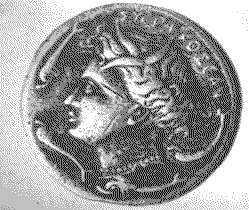
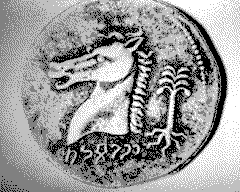
Fig. 11-3 The Alabama coin obverse (left) and reverse (right). Photographs by Sam Banks.
Could the coin lost in the professor's billfold in Alabama have found its way to Cauthron, Arkansas? No. The Alabama coin had no hole at the top, and the inscription was plain and clear with six letters instead of four. The good news was shared with Totten, Fell, and Mahan. The latter sent his excellent photographs of the Alabama coin to Boston. Then Fell was able to translate the inscription. The six marks combined to form five letters: "B Y R S T." The "Y" and "T" are Punic, but the "B," "R," and "S" are in Iberic script. The exact translation is very difficult, according to Fell, but the meaning is similar to "country district." This would indicate that the coin may have been struck in ancient Iberia by Carthaginians, many of whom lived in the city of Gades (modern Cadiz, Spain). Fell has proved by his own research that not only the ancient Carthaginians but also the Iberians migrated to America before the Christian era. It was probably from some Carthaginian territory that the coins were brought to America.
The Alabama coin also shows plainly an inscription above the profile, which was worn off the Arkansas coin, spelling in Greek the name of the city, "Syracuse." Totten verified that the two coins had been struck from the same die, a very significant fact in his opinion. He also stated that coins of this particular type are very rare in the Old World.
The Kansas Coin
In September 1977 I received a telephone call from a stranger in Kansas, who identified himself as Eddie Thornton of Franklin, in the southeastern corner of the state. He said:
"I couldn't sleep until I called you. I just read a back issue of Oklahoma Today magazine with an article you wrote on ancient coins, and I found one just like one of yours. Mine has a woman's profile with dolphins, and a horse head with a date palm, but both are facing left, while yours are facing right."
This discrepancy was due to the fact that the person who had set up the illustrations for the article had, without permission, reversed them for artistic appearance on the page. It apparently had not occurred to the preparer that he was also reversing the writing on the coins.
Thornton said that a year previously, in 1976, he had been searching with a metal detector for a lost ring in a field. The site was near two creeks which flow into the Spring River, which is a tributary of the Arkansas River. The coin was buried 6 inches deep. He said the coin has a hole drilled in the top. As the Alabama coin had no hole and Kelley still had his Arkansas coin, the Kansas coin made three. Thornton obligingly had photographs made for study, and Totten verified that the third coin had also been struck from the same die as the first two.
The Pennsylvania Coin
The January 29, 1978 issue of Family Weekly, the Sunday newspaper insert which has a circulation of about three million, contained an article about my work. The title was "Evidence Proves It: Columbus was a Latecomer." One of the illustrations was the reverse of the Arkansas coin, showing the horse head and date palm. Mail started pouring in from all over the country, many with valuable research leads.
One of the most interesting letters was from a woman in Merced, California. Mini Frank wrote, "I have a coin like the one pictured, similar but not exactly the same, given to me by an old gypsy woman forty years ago. Would you like a picture of it?"
The answering letter included a long questionnaire. Frank returned excellent photographs with a touching story (Fig 11-4). She had worn the coin on a chain around her neck from age five until she married. A loop had been soldered onto the top of the coin so it could be worn as a pendant. It is about the size of a quarter instead of a half-dollar. She noted that the date palm on the back has no roots. The female of the profile was wearing a dangling earring like three pearls instead of a pearl necklace like the Arkansas, Alabama, and Kansas specimens. Otherwise, the design was the same. The inscription above her head differed slightly, but the lettering under the horse head was identical.
Frank related that when she was small, her parents owned a farm in Pennsylvania near the old Baltimore-Philadelphia Pike. Gypsies frequently camped on their land. One group left during the night, disappearing without a trace, deserting an eighty-year-old woman. Frank's mother found her sitting on a box, very ill. She took her in and nursed her back to health. Known only as Florence, she became the child's companion, and taught Frank to count in German, although Florence spoke mostly English. When Frank was five and the old lady lay dying, she took the coin and the chain from her neck and hung it around the little girl's neck, saying, "This is very-very-very-very-very old." She repeated this many times, always with five "very's." Frank had tried for years to obtain an identification of the coin. She was surprised to be told that the five "very's" covered more than two thousand years.
Fell published Frank's photographs of the coin in
his book, Saga America, as an example of an early Carthaginian
coin. He showed how, in this coin, the goddess Arethusa had been
transformed into a Hellenistic version of the Carthaginian goddess
Tanit. The name of Syracuse above her head on this coin was misspelled
"SYRAKOSIAN," believed to be the normal Iberian
Greek form of the genitive case, meaning "Of the Syracusans."
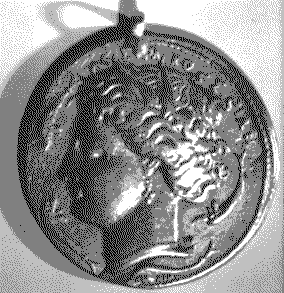
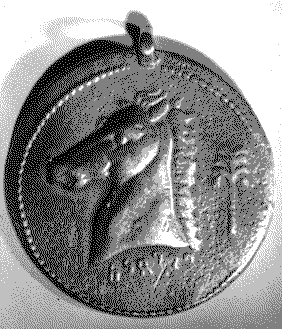
Fig. 11-4 Pennsylvania coin, obverse (left) and reverse (right). Photographs from Mini Frank.
It would be fascinating if it were possible to trace the coin as it was handed down through the centuries to Florence the Gypsy in Pennsylvania.
The Connecticut Coin
Totten reported that a man in Connecticut, Frederick J. Gastonguay of Waterbury, had sent a photograph of a coin to him. Gastonguay had also read the article in Family Weekly, and had noticed that the coin illustrated was a duplicate of a coin that he had carried in his pocket for twenty years, ever since he had found it in a field near Waterbury. This city is near a river which flows to the Atlantic. Although somewhat worn from carrying, the coin is still well preserved, and appears to be another genuine duplicate.
The Nebraska Coin
In 1981 the illustration of the coin printed three years previously in Family Weekly was still achieving results. A letter from Delsa Knapp of Salinas, California, described a coin she had found about 1926, when she was four or five years old. Like the others, this coin had a horse head and palm tree on the back.
Knapp's family had lived on a ten-acre farm near Wolbach, in Greeley County, in central Nebraska. A little stream, a tributary to the North Platte River, ran through the property. In a depression near the river was a cave which her brothers decided to excavate. After digging a hole 5 feet deep and finding nothing, they gave up. Knapp then took her little bucket and spoon and dug a few inches deeper. She found a lump of dirty and corroded metal which she took to her mother. Knapp was told that it was nothing, to throw it away. She didn't. She kept the lump, which proved to be a corroded coin, which had a hole at its top. Knapp cleaned and polished it through the years. Finally, she covered it with clear nail polish to keep it from darkening. As an adult, she had it mounted to wear as a necklace and considered it her "lucky piece."
A commercial photographer produced very clear slides
of the coin on its chain (Fig. 11-5). After inspecting these pictures,
Totten was able to confirm it as another authentic specimen.
Fig. 11-5 Carthagenian coin found by Delsa Knapp, Nebraska.
The Georgia Coin
After the above account of six Carthaginian coins had been written, a seventh was found. The site was in Columbus, Georgia, just across the Chattahoochee River from the site of the duplicate Alabama coin.
The find was reported by Mahan, President of the Institute for the Study of American Cultures, who stated that the Columbus coin was found February 1, 1986, by John Carroll, whom Mahan had known since boyhood. Carroll had been searching with a metal detector for "collectibles" on city property. He sold the coin to Michael O. Smith, but neither the finder nor the purchaser could identify the coin until it was shown to Mahan.
The photographs show that the Columbus coin also has a hole drilled at the top. The familiar four dolphins swim around the profile of the nymph, who again is wearing a pearl necklace. The reverse shows the same inscription below the horse head, and the date palm has five roots.
In April 1988 I talked with Smith in Columbus, Georgia, about this coin. He explained that it was found on Third Avenue, which runs parallel to the river, about 300 yards from the river, between 5th and 6th streets. He said that 5 inches of the original dirt surface had been scraped off, and that the coin was found 8 inches below this new level, which makes the original depth of burial 13 inches. Smith said area residents find pennies dating from 1890's, 3 inches below the surface in the same area.
The Oklahoma Thurium Coins
Two other ancient Mediterranean coins found two of
my friends. They are included here because the three of us work
together and the coins were discovered in the southern and eastern
sections of Oklahoma. The two coins are almost identical and are
of about the same time period as the seven Carthaginian coins
described above. These coins from ancient Italy have been researched
by my colleagues, Dr. Cyclone Covey, of Wake Forest University
of North Carolina, and by Totten.
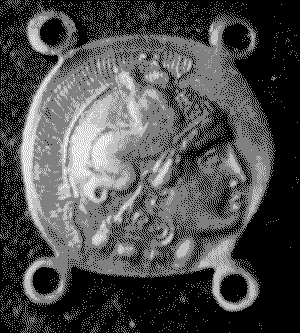
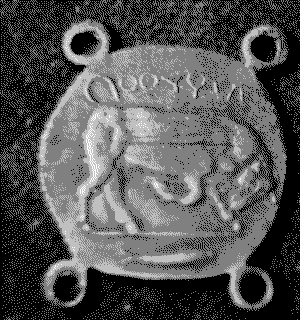
Fig. 11-6 The Thurium Coin, obverse (left) and reverse (right), Terral, Oklahoma. Photographs by Covey.
Covey wrote about a coin made into a medallion by four attached loops (Fig. 11-6). It was found by a fourteen-year-old farm boy, Elbert Martin, in about 1954 or 1955 in a red clay field which had been plowed to a depth of up to 14 inches. The field was 2 miles from Terral, Oklahoma, which is surrounded on three sides by a meander of the Red River. The Red River, the southern boundary of Oklahoma, is a major tributary of the Mississippi River.
The coin that Martin found was made of bronze, minted in Thurium, an Athenian colony in Italy, in approximately 200 B.C. The obverse bears a portrait of Athena, whereas the reverse shows a charging bull over a dolphin.
The second coin which was identical to the Thurium
medallion, except for the absence of attached loops, was found
in eastern Oklahoma by Mrs. Clessie Short, who reported it to
Totten. Short found the coin at Black Gum, which is 3 miles east
of Tenkiller Dam, south of Tahlequah. The Tenkiller Reservoir
is formed by a dam on the Illinois River, which flows into the
Arkansas River. Short found the coin in her chicken yard, where
it apparently had been scratched up from the soil. Totten asks,
"Is it really possible that a collector of ancient Thurium
coins has gone about scattering his material all over eastern
Oklahoma to be dug up by farm boys and chickens?"
Reports of Other Ancient Coins
The following references to other ancient coins are given so they may be pursued by those who are interested. In addition to Braithwaite and Totten, both of whom describe various kinds of coins, Haywood and Pohl list ancient Roman coins found in America, and Gordon discusses ancient Hebrew coins found in Kentucky.
Jeremiah Epstein tabulates forty coins, including most of the above, and concludes that ALL were lost recently. His article is immediately followed by other opinions. The people who agree with him emphasize that the coins were not found in a controlled context. (We had better warn those chickens to keep better records.) Two commentators may be on the fence, as they give points both pro and con. Those who disagree with Epstein point out that he failed to consider the river systems concerning site distribution and refused to consider other supporting evidence. Of course, Epstein did not have access to many other ancient coins which have been reported. Also, there are probably a hundred more lying unreported in various dresser drawers around the country.
In discussing this article, Dr. George F. Carter wrote, "Epsteins's criticism is that the coins have no context, that they do not cluster in time, space or culture. Well, now they do!"
Carter was referring to the Carthaginian coins, the petroglyphs of the goddess Tanit, and the inscriptions in Punic script which I have recorded along the western tributaries to the Mississippi River.
Carter also pointed out another "cluster" of the evidence, compiled by Huston McCulloch, of Jewish occupation in America, consisting of the Hebrew Bar Kokhba coins found in three places in Kentucky between 1932 and 1937, and the famous Bat Creek Inscription from an undisturbed mound in adjacent Tennessee. This inscription was written in Paleo-Hebrew on a stone tablet under the head of a skeleton. Also under the same skull were brass bracelets which could have been made between 45 B.C. and 200 A.D. Remnants of wooden ear-spools, which carbon-dated to between the first and second century A.D., were also in the grave.
Even Christopher Columbus added to the possibility of ancient coins in America. An excerpt from his own journal, dated October 17, 1492, after he had landed on the island they called Fernandina, states that he sent two of his men exploring:
"Here they found a man who had in his nose a piece of gold which might have been half the size of a castenanno, on which they saw letters. I was angry with them because they had not bargained for it and given whatever might be asked, in order that it might be examined and seen what money it was, and they replied to me that they had not dared to bargain for it."
The one ancient coin which has received the most national publicity is the Norse penny found in Maine, which was authenticated in 1978 by Seaby's of London and in 1979 by the Chief Curator of Coin Studies at the University of Oslo. One facet of this story not generally known is included in a letter from the State Archaeologist of Maine, explaining the lapse of twenty-two years from the time the coin was found until it was authenticated. Although the finder knew the coin was pre-Columbian, either English or Norse, he, his friends, and the State Archaeologist of Maine, did not report the find because of "immediate and violent opposition of professionals to all claims of Viking-related finds." The coin was not verified as Norse until after the death of the finder.
Empathetic understanding is offered. How many diffusionists are forced to postpone reporting important discoveries, whether coins or other evidence, until publication is considered "safe?"
Although some of the coins presented in this chapter do not have a verifiable context, still there is enough evidence to be considered that coins were brought here anciently. It is hoped that more coins will emerge as the readers of this book become aware of what they possess. The report of coins by many authors bolsters the validity of the inscriptions, in many ancient scripts, recorded in America.
Other artifacts actually made in America, and not
carried in, are described in the next chapter.